Comprehensive Analysis of Health Determinants and Their Consequences
VerifiedAdded on 2023/01/16
|10
|2856
|28
Report
AI Summary
This report delves into the multifaceted determinants of health, encompassing lifestyle choices like smoking, biological factors such as disability, and environmental elements like housing conditions. It examines how these factors influence individual and community health, highlighting health inequalities and their impact. The report provides data and statistics, particularly within the UK context, and explores governmental strategies, policies, and laws designed to mitigate the adverse effects of these determinants. Key areas of focus include the impact of smoking on health, the challenges faced by individuals with disabilities, and the effects of poor housing on overall well-being. The report concludes by emphasizing the critical importance of addressing these determinants to ensure a healthy and equitable society, summarizing the various factors that affect health and the policies aimed at improvement.

Determinants of Health
Paraphrase This Document
Need a fresh take? Get an instant paraphrase of this document with our AI Paraphraser

Table of Contents
INTRODUCTION...........................................................................................................................3
MAIN BODY...................................................................................................................................3
The way different determinants of health influence on individual and community health.........3
CONCLUSION................................................................................................................................7
REFERENCES................................................................................................................................9
INTRODUCTION...........................................................................................................................3
MAIN BODY...................................................................................................................................3
The way different determinants of health influence on individual and community health.........3
CONCLUSION................................................................................................................................7
REFERENCES................................................................................................................................9

INTRODUCTION
Determinants of Health refers to the variety of factors that impacts health state of
individuals or groups. It includes social, behavioural, biological, economic and physical
determinants that influence the health of people adversely (Adler, Glymour and Fielding, 2016).
Health inequities are characterised as the systematic differences in status of health of different
groups of population. This report covers the concept of health and health inequality along with
different determinants of health. The ill effects of smoking, disability and bad housing condition
are determined. Apart from this, the facts and figures associated with determinants in context of
UK and government strategies, policies or laws to minimise those are included in this report.
MAIN BODY
The way different determinants of health influence on individual and community health
Health is defined as the state of complete emotional, mental, social and physical well
being, not simply the absence of infirmity or disease. It is not merely the disease absence, but the
capability of an individual to recover and bounce back from ill health or other issues (What is
good health?, 2020). Genetics, relationships, education and environment are the factors that
includes in good health. In the wider society, it is the resource to support the function of an
individual. Health is the capability of body to adapt with new infirmities and threats. The health
of an individual can be impacted by cultural factors. For instance: around the Mediterranean,
individuals are more likely to intake high level of olive, vegetables and fruits and to eat as a
family, in comparison to cultures with high intake of fast food. Apart from this, the health is also
impacted by the way an individual manages stress. People who takes drugs, smoke or drink in
order to forget their problems or difficulties in life are likely to have more problems associated
with health, as compared to people who combats by exercise and healthful diet (Ahnquist,
Wamala and Lindstrom, 2012).
Health inequity refers to the differences in state of health or in distribution of resources
associated with health between distinct population groups that arises from the condition in which
individuals are born, grow, work and live. There are numerous evidence that social forces have a
marked impact on health of a person. These including income level, education, gender,
employment status and ethnicity (10 facts on health inequities and their causes, 2017). These
have significant economic and social costs to both people as well as society. For instance: In
Determinants of Health refers to the variety of factors that impacts health state of
individuals or groups. It includes social, behavioural, biological, economic and physical
determinants that influence the health of people adversely (Adler, Glymour and Fielding, 2016).
Health inequities are characterised as the systematic differences in status of health of different
groups of population. This report covers the concept of health and health inequality along with
different determinants of health. The ill effects of smoking, disability and bad housing condition
are determined. Apart from this, the facts and figures associated with determinants in context of
UK and government strategies, policies or laws to minimise those are included in this report.
MAIN BODY
The way different determinants of health influence on individual and community health
Health is defined as the state of complete emotional, mental, social and physical well
being, not simply the absence of infirmity or disease. It is not merely the disease absence, but the
capability of an individual to recover and bounce back from ill health or other issues (What is
good health?, 2020). Genetics, relationships, education and environment are the factors that
includes in good health. In the wider society, it is the resource to support the function of an
individual. Health is the capability of body to adapt with new infirmities and threats. The health
of an individual can be impacted by cultural factors. For instance: around the Mediterranean,
individuals are more likely to intake high level of olive, vegetables and fruits and to eat as a
family, in comparison to cultures with high intake of fast food. Apart from this, the health is also
impacted by the way an individual manages stress. People who takes drugs, smoke or drink in
order to forget their problems or difficulties in life are likely to have more problems associated
with health, as compared to people who combats by exercise and healthful diet (Ahnquist,
Wamala and Lindstrom, 2012).
Health inequity refers to the differences in state of health or in distribution of resources
associated with health between distinct population groups that arises from the condition in which
individuals are born, grow, work and live. There are numerous evidence that social forces have a
marked impact on health of a person. These including income level, education, gender,
employment status and ethnicity (10 facts on health inequities and their causes, 2017). These
have significant economic and social costs to both people as well as society. For instance: In
⊘ This is a preview!⊘
Do you want full access?
Subscribe today to unlock all pages.

Trusted by 1+ million students worldwide
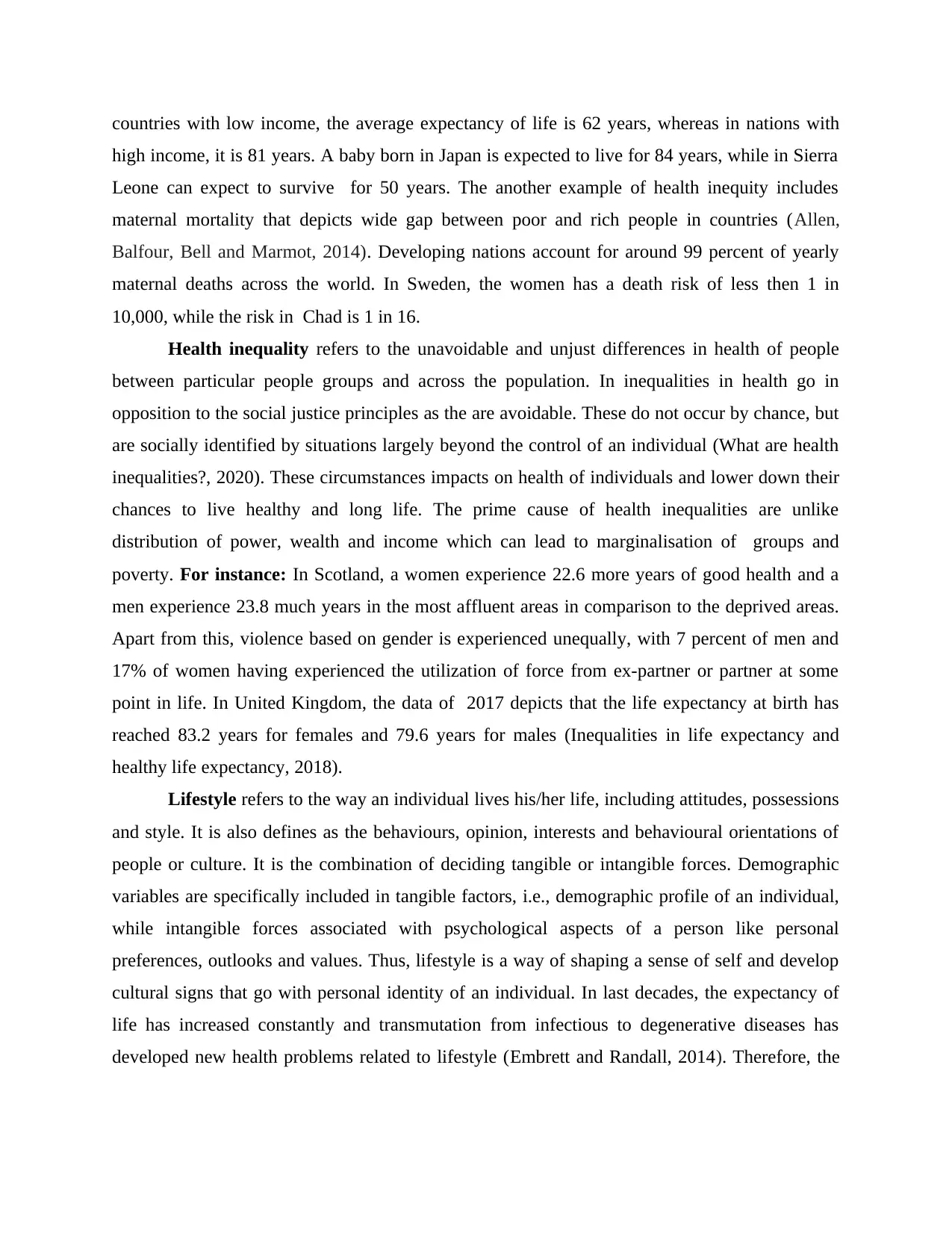
countries with low income, the average expectancy of life is 62 years, whereas in nations with
high income, it is 81 years. A baby born in Japan is expected to live for 84 years, while in Sierra
Leone can expect to survive for 50 years. The another example of health inequity includes
maternal mortality that depicts wide gap between poor and rich people in countries (Allen,
Balfour, Bell and Marmot, 2014). Developing nations account for around 99 percent of yearly
maternal deaths across the world. In Sweden, the women has a death risk of less then 1 in
10,000, while the risk in Chad is 1 in 16.
Health inequality refers to the unavoidable and unjust differences in health of people
between particular people groups and across the population. In inequalities in health go in
opposition to the social justice principles as the are avoidable. These do not occur by chance, but
are socially identified by situations largely beyond the control of an individual (What are health
inequalities?, 2020). These circumstances impacts on health of individuals and lower down their
chances to live healthy and long life. The prime cause of health inequalities are unlike
distribution of power, wealth and income which can lead to marginalisation of groups and
poverty. For instance: In Scotland, a women experience 22.6 more years of good health and a
men experience 23.8 much years in the most affluent areas in comparison to the deprived areas.
Apart from this, violence based on gender is experienced unequally, with 7 percent of men and
17% of women having experienced the utilization of force from ex-partner or partner at some
point in life. In United Kingdom, the data of 2017 depicts that the life expectancy at birth has
reached 83.2 years for females and 79.6 years for males (Inequalities in life expectancy and
healthy life expectancy, 2018).
Lifestyle refers to the way an individual lives his/her life, including attitudes, possessions
and style. It is also defines as the behaviours, opinion, interests and behavioural orientations of
people or culture. It is the combination of deciding tangible or intangible forces. Demographic
variables are specifically included in tangible factors, i.e., demographic profile of an individual,
while intangible forces associated with psychological aspects of a person like personal
preferences, outlooks and values. Thus, lifestyle is a way of shaping a sense of self and develop
cultural signs that go with personal identity of an individual. In last decades, the expectancy of
life has increased constantly and transmutation from infectious to degenerative diseases has
developed new health problems related to lifestyle (Embrett and Randall, 2014). Therefore, the
high income, it is 81 years. A baby born in Japan is expected to live for 84 years, while in Sierra
Leone can expect to survive for 50 years. The another example of health inequity includes
maternal mortality that depicts wide gap between poor and rich people in countries (Allen,
Balfour, Bell and Marmot, 2014). Developing nations account for around 99 percent of yearly
maternal deaths across the world. In Sweden, the women has a death risk of less then 1 in
10,000, while the risk in Chad is 1 in 16.
Health inequality refers to the unavoidable and unjust differences in health of people
between particular people groups and across the population. In inequalities in health go in
opposition to the social justice principles as the are avoidable. These do not occur by chance, but
are socially identified by situations largely beyond the control of an individual (What are health
inequalities?, 2020). These circumstances impacts on health of individuals and lower down their
chances to live healthy and long life. The prime cause of health inequalities are unlike
distribution of power, wealth and income which can lead to marginalisation of groups and
poverty. For instance: In Scotland, a women experience 22.6 more years of good health and a
men experience 23.8 much years in the most affluent areas in comparison to the deprived areas.
Apart from this, violence based on gender is experienced unequally, with 7 percent of men and
17% of women having experienced the utilization of force from ex-partner or partner at some
point in life. In United Kingdom, the data of 2017 depicts that the life expectancy at birth has
reached 83.2 years for females and 79.6 years for males (Inequalities in life expectancy and
healthy life expectancy, 2018).
Lifestyle refers to the way an individual lives his/her life, including attitudes, possessions
and style. It is also defines as the behaviours, opinion, interests and behavioural orientations of
people or culture. It is the combination of deciding tangible or intangible forces. Demographic
variables are specifically included in tangible factors, i.e., demographic profile of an individual,
while intangible forces associated with psychological aspects of a person like personal
preferences, outlooks and values. Thus, lifestyle is a way of shaping a sense of self and develop
cultural signs that go with personal identity of an individual. In last decades, the expectancy of
life has increased constantly and transmutation from infectious to degenerative diseases has
developed new health problems related to lifestyle (Embrett and Randall, 2014). Therefore, the
Paraphrase This Document
Need a fresh take? Get an instant paraphrase of this document with our AI Paraphraser
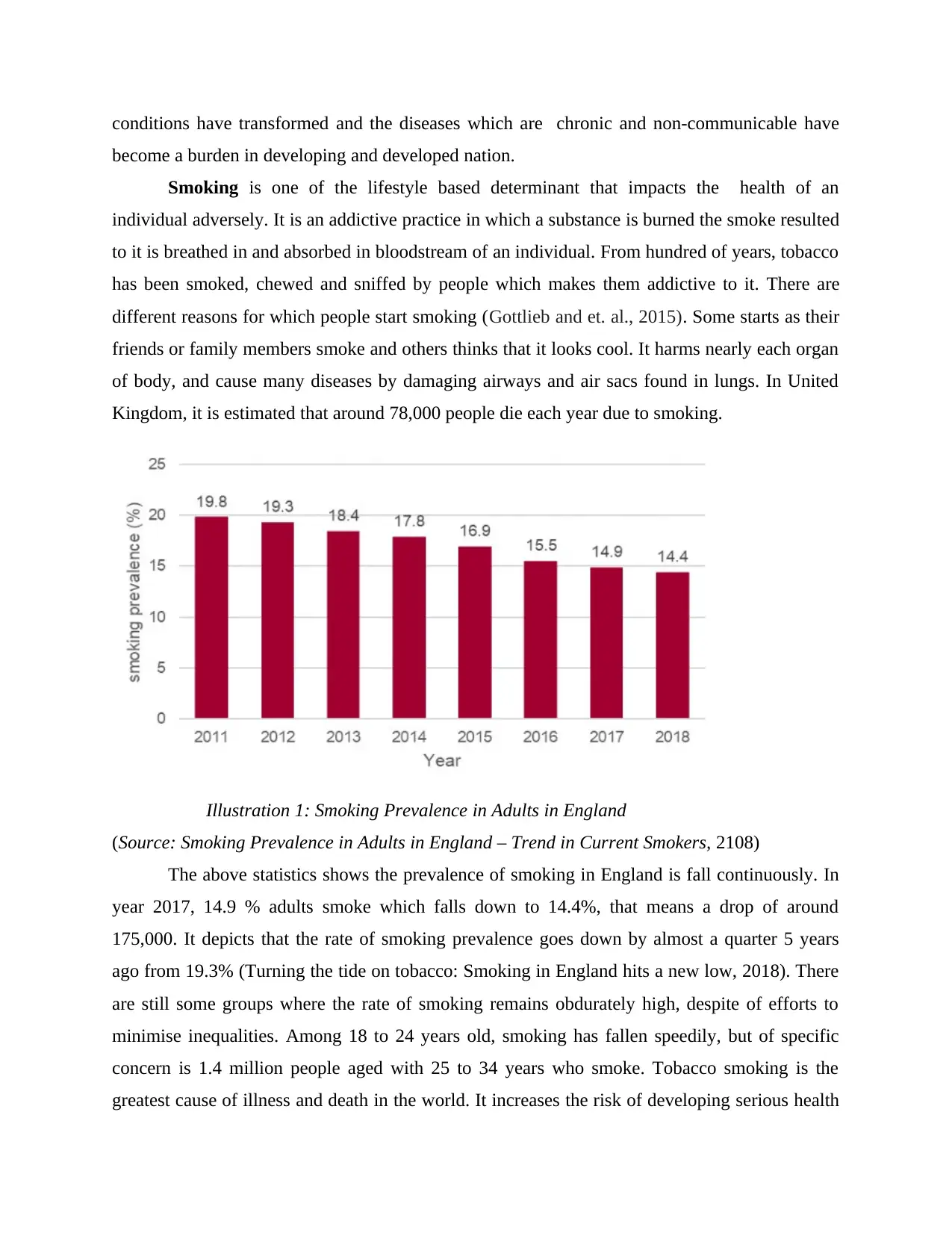
conditions have transformed and the diseases which are chronic and non-communicable have
become a burden in developing and developed nation.
Smoking is one of the lifestyle based determinant that impacts the health of an
individual adversely. It is an addictive practice in which a substance is burned the smoke resulted
to it is breathed in and absorbed in bloodstream of an individual. From hundred of years, tobacco
has been smoked, chewed and sniffed by people which makes them addictive to it. There are
different reasons for which people start smoking (Gottlieb and et. al., 2015). Some starts as their
friends or family members smoke and others thinks that it looks cool. It harms nearly each organ
of body, and cause many diseases by damaging airways and air sacs found in lungs. In United
Kingdom, it is estimated that around 78,000 people die each year due to smoking.
Illustration 1: Smoking Prevalence in Adults in England
(Source: Smoking Prevalence in Adults in England – Trend in Current Smokers, 2108)
The above statistics shows the prevalence of smoking in England is fall continuously. In
year 2017, 14.9 % adults smoke which falls down to 14.4%, that means a drop of around
175,000. It depicts that the rate of smoking prevalence goes down by almost a quarter 5 years
ago from 19.3% (Turning the tide on tobacco: Smoking in England hits a new low, 2018). There
are still some groups where the rate of smoking remains obdurately high, despite of efforts to
minimise inequalities. Among 18 to 24 years old, smoking has fallen speedily, but of specific
concern is 1.4 million people aged with 25 to 34 years who smoke. Tobacco smoking is the
greatest cause of illness and death in the world. It increases the risk of developing serious health
become a burden in developing and developed nation.
Smoking is one of the lifestyle based determinant that impacts the health of an
individual adversely. It is an addictive practice in which a substance is burned the smoke resulted
to it is breathed in and absorbed in bloodstream of an individual. From hundred of years, tobacco
has been smoked, chewed and sniffed by people which makes them addictive to it. There are
different reasons for which people start smoking (Gottlieb and et. al., 2015). Some starts as their
friends or family members smoke and others thinks that it looks cool. It harms nearly each organ
of body, and cause many diseases by damaging airways and air sacs found in lungs. In United
Kingdom, it is estimated that around 78,000 people die each year due to smoking.
Illustration 1: Smoking Prevalence in Adults in England
(Source: Smoking Prevalence in Adults in England – Trend in Current Smokers, 2108)
The above statistics shows the prevalence of smoking in England is fall continuously. In
year 2017, 14.9 % adults smoke which falls down to 14.4%, that means a drop of around
175,000. It depicts that the rate of smoking prevalence goes down by almost a quarter 5 years
ago from 19.3% (Turning the tide on tobacco: Smoking in England hits a new low, 2018). There
are still some groups where the rate of smoking remains obdurately high, despite of efforts to
minimise inequalities. Among 18 to 24 years old, smoking has fallen speedily, but of specific
concern is 1.4 million people aged with 25 to 34 years who smoke. Tobacco smoking is the
greatest cause of illness and death in the world. It increases the risk of developing serious health
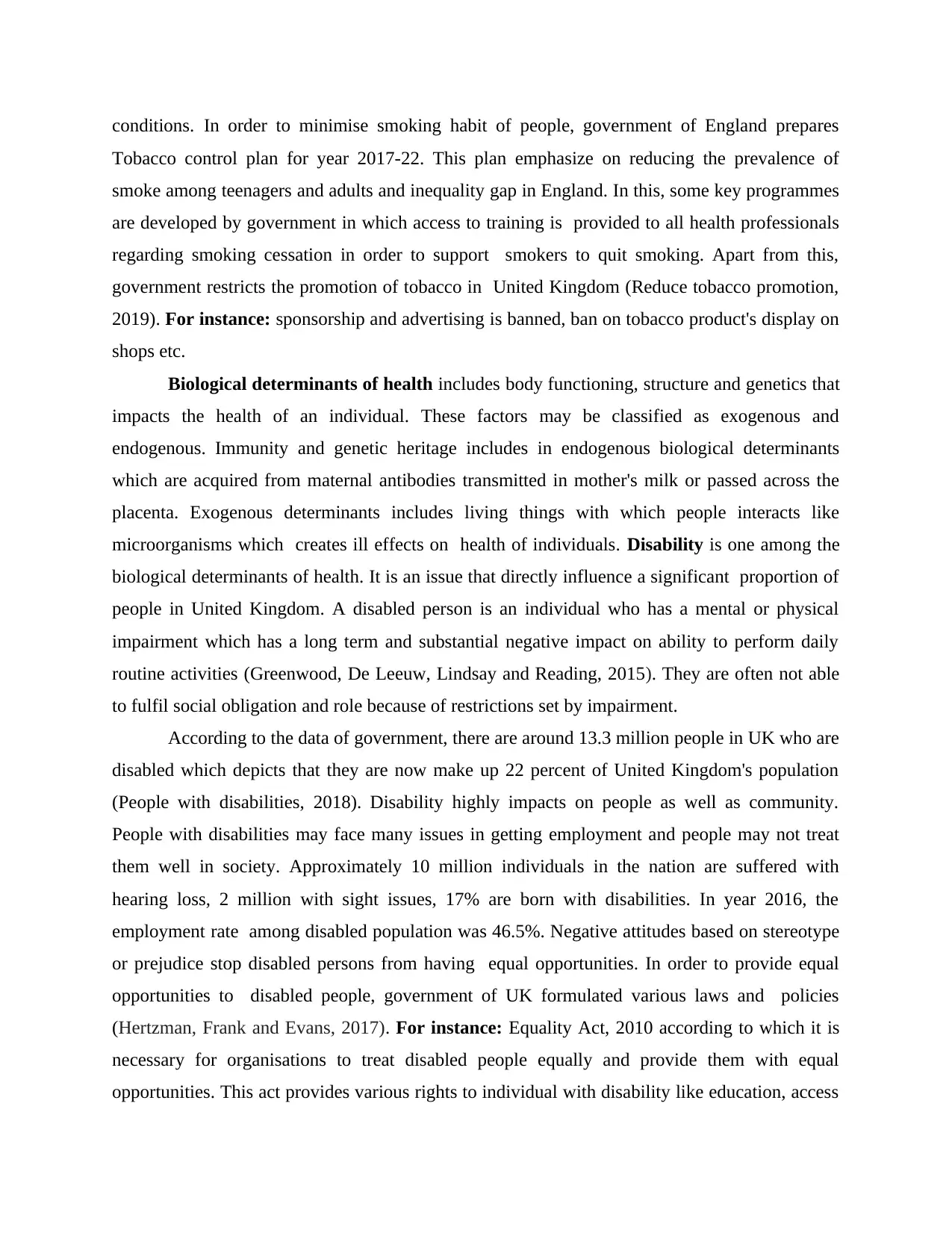
conditions. In order to minimise smoking habit of people, government of England prepares
Tobacco control plan for year 2017-22. This plan emphasize on reducing the prevalence of
smoke among teenagers and adults and inequality gap in England. In this, some key programmes
are developed by government in which access to training is provided to all health professionals
regarding smoking cessation in order to support smokers to quit smoking. Apart from this,
government restricts the promotion of tobacco in United Kingdom (Reduce tobacco promotion,
2019). For instance: sponsorship and advertising is banned, ban on tobacco product's display on
shops etc.
Biological determinants of health includes body functioning, structure and genetics that
impacts the health of an individual. These factors may be classified as exogenous and
endogenous. Immunity and genetic heritage includes in endogenous biological determinants
which are acquired from maternal antibodies transmitted in mother's milk or passed across the
placenta. Exogenous determinants includes living things with which people interacts like
microorganisms which creates ill effects on health of individuals. Disability is one among the
biological determinants of health. It is an issue that directly influence a significant proportion of
people in United Kingdom. A disabled person is an individual who has a mental or physical
impairment which has a long term and substantial negative impact on ability to perform daily
routine activities (Greenwood, De Leeuw, Lindsay and Reading, 2015). They are often not able
to fulfil social obligation and role because of restrictions set by impairment.
According to the data of government, there are around 13.3 million people in UK who are
disabled which depicts that they are now make up 22 percent of United Kingdom's population
(People with disabilities, 2018). Disability highly impacts on people as well as community.
People with disabilities may face many issues in getting employment and people may not treat
them well in society. Approximately 10 million individuals in the nation are suffered with
hearing loss, 2 million with sight issues, 17% are born with disabilities. In year 2016, the
employment rate among disabled population was 46.5%. Negative attitudes based on stereotype
or prejudice stop disabled persons from having equal opportunities. In order to provide equal
opportunities to disabled people, government of UK formulated various laws and policies
(Hertzman, Frank and Evans, 2017). For instance: Equality Act, 2010 according to which it is
necessary for organisations to treat disabled people equally and provide them with equal
opportunities. This act provides various rights to individual with disability like education, access
Tobacco control plan for year 2017-22. This plan emphasize on reducing the prevalence of
smoke among teenagers and adults and inequality gap in England. In this, some key programmes
are developed by government in which access to training is provided to all health professionals
regarding smoking cessation in order to support smokers to quit smoking. Apart from this,
government restricts the promotion of tobacco in United Kingdom (Reduce tobacco promotion,
2019). For instance: sponsorship and advertising is banned, ban on tobacco product's display on
shops etc.
Biological determinants of health includes body functioning, structure and genetics that
impacts the health of an individual. These factors may be classified as exogenous and
endogenous. Immunity and genetic heritage includes in endogenous biological determinants
which are acquired from maternal antibodies transmitted in mother's milk or passed across the
placenta. Exogenous determinants includes living things with which people interacts like
microorganisms which creates ill effects on health of individuals. Disability is one among the
biological determinants of health. It is an issue that directly influence a significant proportion of
people in United Kingdom. A disabled person is an individual who has a mental or physical
impairment which has a long term and substantial negative impact on ability to perform daily
routine activities (Greenwood, De Leeuw, Lindsay and Reading, 2015). They are often not able
to fulfil social obligation and role because of restrictions set by impairment.
According to the data of government, there are around 13.3 million people in UK who are
disabled which depicts that they are now make up 22 percent of United Kingdom's population
(People with disabilities, 2018). Disability highly impacts on people as well as community.
People with disabilities may face many issues in getting employment and people may not treat
them well in society. Approximately 10 million individuals in the nation are suffered with
hearing loss, 2 million with sight issues, 17% are born with disabilities. In year 2016, the
employment rate among disabled population was 46.5%. Negative attitudes based on stereotype
or prejudice stop disabled persons from having equal opportunities. In order to provide equal
opportunities to disabled people, government of UK formulated various laws and policies
(Hertzman, Frank and Evans, 2017). For instance: Equality Act, 2010 according to which it is
necessary for organisations to treat disabled people equally and provide them with equal
opportunities. This act provides various rights to individual with disability like education, access
⊘ This is a preview!⊘
Do you want full access?
Subscribe today to unlock all pages.

Trusted by 1+ million students worldwide
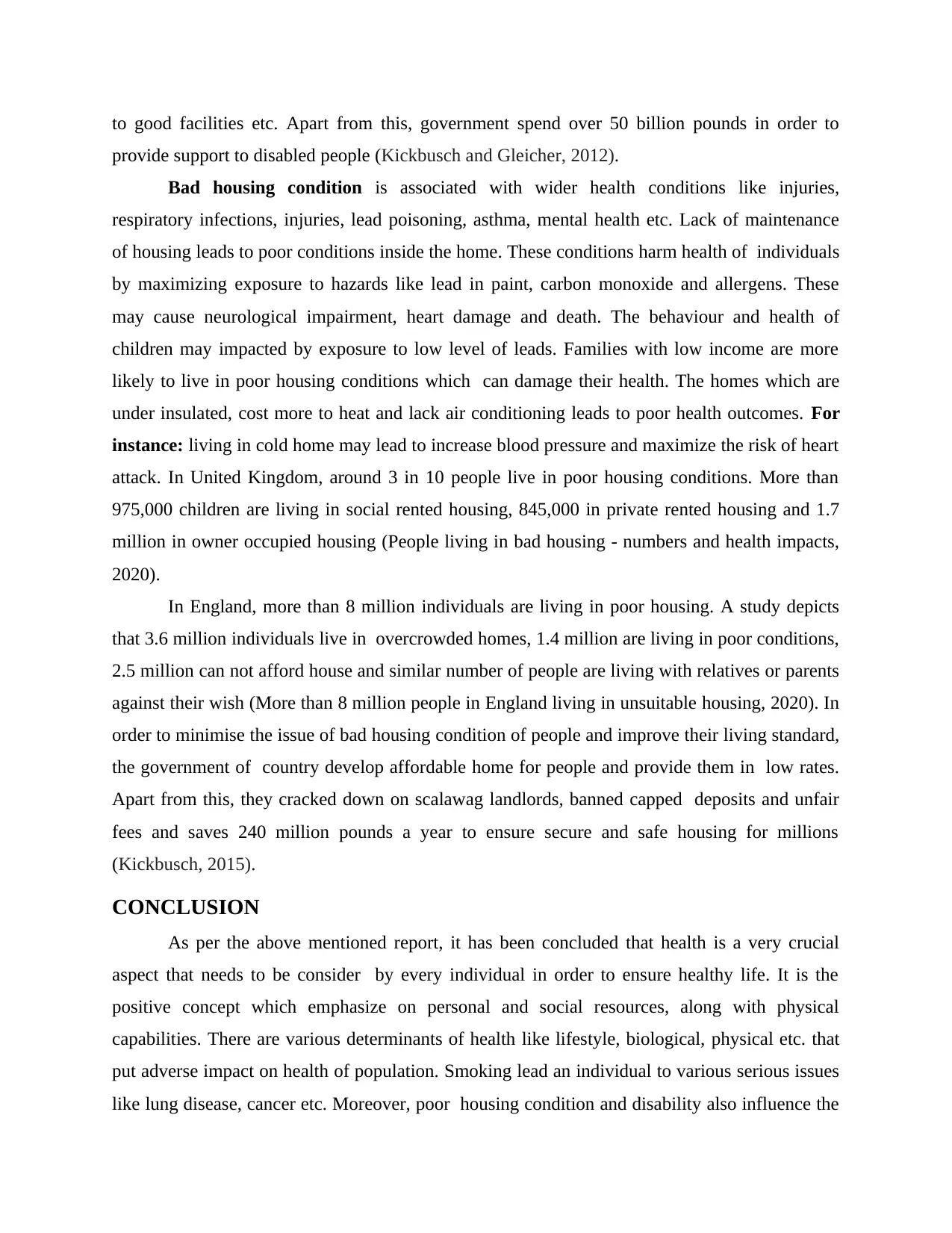
to good facilities etc. Apart from this, government spend over 50 billion pounds in order to
provide support to disabled people (Kickbusch and Gleicher, 2012).
Bad housing condition is associated with wider health conditions like injuries,
respiratory infections, injuries, lead poisoning, asthma, mental health etc. Lack of maintenance
of housing leads to poor conditions inside the home. These conditions harm health of individuals
by maximizing exposure to hazards like lead in paint, carbon monoxide and allergens. These
may cause neurological impairment, heart damage and death. The behaviour and health of
children may impacted by exposure to low level of leads. Families with low income are more
likely to live in poor housing conditions which can damage their health. The homes which are
under insulated, cost more to heat and lack air conditioning leads to poor health outcomes. For
instance: living in cold home may lead to increase blood pressure and maximize the risk of heart
attack. In United Kingdom, around 3 in 10 people live in poor housing conditions. More than
975,000 children are living in social rented housing, 845,000 in private rented housing and 1.7
million in owner occupied housing (People living in bad housing - numbers and health impacts,
2020).
In England, more than 8 million individuals are living in poor housing. A study depicts
that 3.6 million individuals live in overcrowded homes, 1.4 million are living in poor conditions,
2.5 million can not afford house and similar number of people are living with relatives or parents
against their wish (More than 8 million people in England living in unsuitable housing, 2020). In
order to minimise the issue of bad housing condition of people and improve their living standard,
the government of country develop affordable home for people and provide them in low rates.
Apart from this, they cracked down on scalawag landlords, banned capped deposits and unfair
fees and saves 240 million pounds a year to ensure secure and safe housing for millions
(Kickbusch, 2015).
CONCLUSION
As per the above mentioned report, it has been concluded that health is a very crucial
aspect that needs to be consider by every individual in order to ensure healthy life. It is the
positive concept which emphasize on personal and social resources, along with physical
capabilities. There are various determinants of health like lifestyle, biological, physical etc. that
put adverse impact on health of population. Smoking lead an individual to various serious issues
like lung disease, cancer etc. Moreover, poor housing condition and disability also influence the
provide support to disabled people (Kickbusch and Gleicher, 2012).
Bad housing condition is associated with wider health conditions like injuries,
respiratory infections, injuries, lead poisoning, asthma, mental health etc. Lack of maintenance
of housing leads to poor conditions inside the home. These conditions harm health of individuals
by maximizing exposure to hazards like lead in paint, carbon monoxide and allergens. These
may cause neurological impairment, heart damage and death. The behaviour and health of
children may impacted by exposure to low level of leads. Families with low income are more
likely to live in poor housing conditions which can damage their health. The homes which are
under insulated, cost more to heat and lack air conditioning leads to poor health outcomes. For
instance: living in cold home may lead to increase blood pressure and maximize the risk of heart
attack. In United Kingdom, around 3 in 10 people live in poor housing conditions. More than
975,000 children are living in social rented housing, 845,000 in private rented housing and 1.7
million in owner occupied housing (People living in bad housing - numbers and health impacts,
2020).
In England, more than 8 million individuals are living in poor housing. A study depicts
that 3.6 million individuals live in overcrowded homes, 1.4 million are living in poor conditions,
2.5 million can not afford house and similar number of people are living with relatives or parents
against their wish (More than 8 million people in England living in unsuitable housing, 2020). In
order to minimise the issue of bad housing condition of people and improve their living standard,
the government of country develop affordable home for people and provide them in low rates.
Apart from this, they cracked down on scalawag landlords, banned capped deposits and unfair
fees and saves 240 million pounds a year to ensure secure and safe housing for millions
(Kickbusch, 2015).
CONCLUSION
As per the above mentioned report, it has been concluded that health is a very crucial
aspect that needs to be consider by every individual in order to ensure healthy life. It is the
positive concept which emphasize on personal and social resources, along with physical
capabilities. There are various determinants of health like lifestyle, biological, physical etc. that
put adverse impact on health of population. Smoking lead an individual to various serious issues
like lung disease, cancer etc. Moreover, poor housing condition and disability also influence the
Paraphrase This Document
Need a fresh take? Get an instant paraphrase of this document with our AI Paraphraser

life of individual. In order to ensure healthy life of people, government put various efforts and
implement various strategies and policies to improve health of people.
implement various strategies and policies to improve health of people.
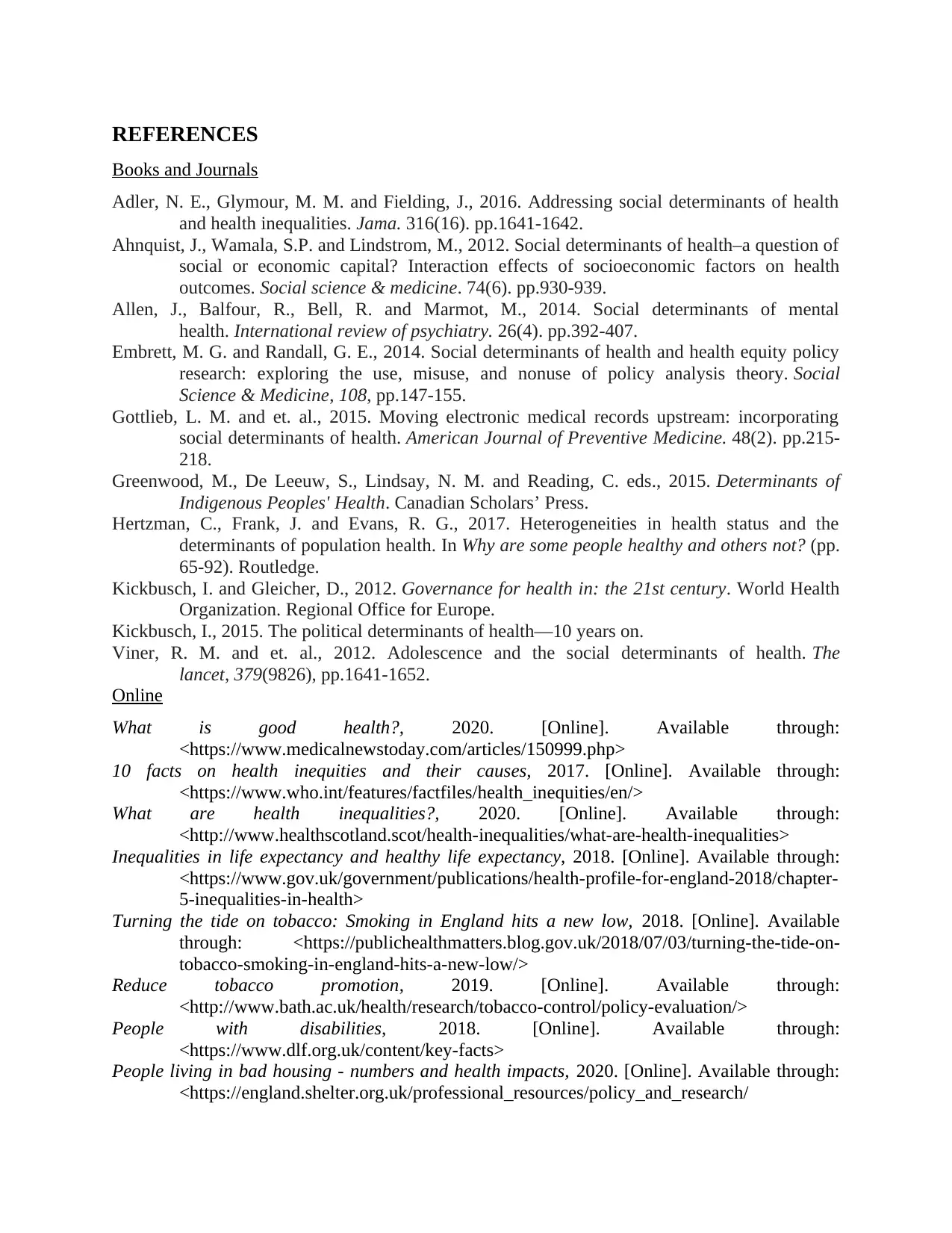
REFERENCES
Books and Journals
Adler, N. E., Glymour, M. M. and Fielding, J., 2016. Addressing social determinants of health
and health inequalities. Jama. 316(16). pp.1641-1642.
Ahnquist, J., Wamala, S.P. and Lindstrom, M., 2012. Social determinants of health–a question of
social or economic capital? Interaction effects of socioeconomic factors on health
outcomes. Social science & medicine. 74(6). pp.930-939.
Allen, J., Balfour, R., Bell, R. and Marmot, M., 2014. Social determinants of mental
health. International review of psychiatry. 26(4). pp.392-407.
Embrett, M. G. and Randall, G. E., 2014. Social determinants of health and health equity policy
research: exploring the use, misuse, and nonuse of policy analysis theory. Social
Science & Medicine, 108, pp.147-155.
Gottlieb, L. M. and et. al., 2015. Moving electronic medical records upstream: incorporating
social determinants of health. American Journal of Preventive Medicine. 48(2). pp.215-
218.
Greenwood, M., De Leeuw, S., Lindsay, N. M. and Reading, C. eds., 2015. Determinants of
Indigenous Peoples' Health. Canadian Scholars’ Press.
Hertzman, C., Frank, J. and Evans, R. G., 2017. Heterogeneities in health status and the
determinants of population health. In Why are some people healthy and others not? (pp.
65-92). Routledge.
Kickbusch, I. and Gleicher, D., 2012. Governance for health in: the 21st century. World Health
Organization. Regional Office for Europe.
Kickbusch, I., 2015. The political determinants of health—10 years on.
Viner, R. M. and et. al., 2012. Adolescence and the social determinants of health. The
lancet, 379(9826), pp.1641-1652.
Online
What is good health?, 2020. [Online]. Available through:
<https://www.medicalnewstoday.com/articles/150999.php>
10 facts on health inequities and their causes, 2017. [Online]. Available through:
<https://www.who.int/features/factfiles/health_inequities/en/>
What are health inequalities?, 2020. [Online]. Available through:
<http://www.healthscotland.scot/health-inequalities/what-are-health-inequalities>
Inequalities in life expectancy and healthy life expectancy, 2018. [Online]. Available through:
<https://www.gov.uk/government/publications/health-profile-for-england-2018/chapter-
5-inequalities-in-health>
Turning the tide on tobacco: Smoking in England hits a new low, 2018. [Online]. Available
through: <https://publichealthmatters.blog.gov.uk/2018/07/03/turning-the-tide-on-
tobacco-smoking-in-england-hits-a-new-low/>
Reduce tobacco promotion, 2019. [Online]. Available through:
<http://www.bath.ac.uk/health/research/tobacco-control/policy-evaluation/>
People with disabilities, 2018. [Online]. Available through:
<https://www.dlf.org.uk/content/key-facts>
People living in bad housing - numbers and health impacts, 2020. [Online]. Available through:
<https://england.shelter.org.uk/professional_resources/policy_and_research/
Books and Journals
Adler, N. E., Glymour, M. M. and Fielding, J., 2016. Addressing social determinants of health
and health inequalities. Jama. 316(16). pp.1641-1642.
Ahnquist, J., Wamala, S.P. and Lindstrom, M., 2012. Social determinants of health–a question of
social or economic capital? Interaction effects of socioeconomic factors on health
outcomes. Social science & medicine. 74(6). pp.930-939.
Allen, J., Balfour, R., Bell, R. and Marmot, M., 2014. Social determinants of mental
health. International review of psychiatry. 26(4). pp.392-407.
Embrett, M. G. and Randall, G. E., 2014. Social determinants of health and health equity policy
research: exploring the use, misuse, and nonuse of policy analysis theory. Social
Science & Medicine, 108, pp.147-155.
Gottlieb, L. M. and et. al., 2015. Moving electronic medical records upstream: incorporating
social determinants of health. American Journal of Preventive Medicine. 48(2). pp.215-
218.
Greenwood, M., De Leeuw, S., Lindsay, N. M. and Reading, C. eds., 2015. Determinants of
Indigenous Peoples' Health. Canadian Scholars’ Press.
Hertzman, C., Frank, J. and Evans, R. G., 2017. Heterogeneities in health status and the
determinants of population health. In Why are some people healthy and others not? (pp.
65-92). Routledge.
Kickbusch, I. and Gleicher, D., 2012. Governance for health in: the 21st century. World Health
Organization. Regional Office for Europe.
Kickbusch, I., 2015. The political determinants of health—10 years on.
Viner, R. M. and et. al., 2012. Adolescence and the social determinants of health. The
lancet, 379(9826), pp.1641-1652.
Online
What is good health?, 2020. [Online]. Available through:
<https://www.medicalnewstoday.com/articles/150999.php>
10 facts on health inequities and their causes, 2017. [Online]. Available through:
<https://www.who.int/features/factfiles/health_inequities/en/>
What are health inequalities?, 2020. [Online]. Available through:
<http://www.healthscotland.scot/health-inequalities/what-are-health-inequalities>
Inequalities in life expectancy and healthy life expectancy, 2018. [Online]. Available through:
<https://www.gov.uk/government/publications/health-profile-for-england-2018/chapter-
5-inequalities-in-health>
Turning the tide on tobacco: Smoking in England hits a new low, 2018. [Online]. Available
through: <https://publichealthmatters.blog.gov.uk/2018/07/03/turning-the-tide-on-
tobacco-smoking-in-england-hits-a-new-low/>
Reduce tobacco promotion, 2019. [Online]. Available through:
<http://www.bath.ac.uk/health/research/tobacco-control/policy-evaluation/>
People with disabilities, 2018. [Online]. Available through:
<https://www.dlf.org.uk/content/key-facts>
People living in bad housing - numbers and health impacts, 2020. [Online]. Available through:
<https://england.shelter.org.uk/professional_resources/policy_and_research/
⊘ This is a preview!⊘
Do you want full access?
Subscribe today to unlock all pages.

Trusted by 1+ million students worldwide

policy_library/policy_library_folder/people_living_in_bad_housing_-
_numbers_and_health_impacts>
More than 8 million people in England living in unsuitable housing, 2020. [Online]. Available
through: <https://www.theguardian.com/society/2019/sep/23/people-england-living-
unsuitable-housing>
_numbers_and_health_impacts>
More than 8 million people in England living in unsuitable housing, 2020. [Online]. Available
through: <https://www.theguardian.com/society/2019/sep/23/people-england-living-
unsuitable-housing>
1 out of 10
Related Documents
Your All-in-One AI-Powered Toolkit for Academic Success.
+13062052269
info@desklib.com
Available 24*7 on WhatsApp / Email
![[object Object]](/_next/static/media/star-bottom.7253800d.svg)
Unlock your academic potential
Copyright © 2020–2025 A2Z Services. All Rights Reserved. Developed and managed by ZUCOL.





